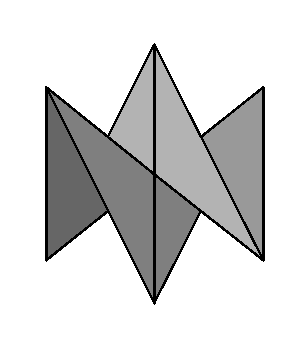- Maxima
- Points where the surface is locally below the height of the
critical point. A component of the
level set
disappears as the height passes a maximum. A maximum typically looks
like the origin in
z = -x^2 - y^2.
- Minima
- Points where the surface is locally above the height of the
critical point. A new component of the level set is formed as the
height passes a minimum. A minimum typically looks like the origin in
z = x^2 + y^2.
- Saddles
- Points where every neighborhood of the critical point
intersects the plane perpendicular to the height direction. The
number of components in the
level set
usually changes as the height passes a saddle point. If the surface is
non-orientable,
however, the number of components may stay the same, as is the case
with the projective plane drawn by Kuiper with only three critical
points.
![[More]](../pix/Link.gif)
A saddle typically looks like the origin in z = x^2 - y^2. This is a surface that goes up in two places and down in two places. There are more complicated saddles (with more ups and downs). In the case of smooth surfaces, these are not generic: a slight change of direction will break the saddle into two ore more standard saddles. This is not true for polyhedral surfaces, where complex saddles are stable under slight changes of direction. There are also "exotic" saddles that have no smooth counterpart, as in the diagram below.

![[TOC]](../pix/TOC.gif)
![[Index]](../pix/Index.gif)
![[Glossary]](../pix/Glossary.gif)
![[Mail]](../pix/Mail.gif)
![[Help]](../pix/Help.gif)